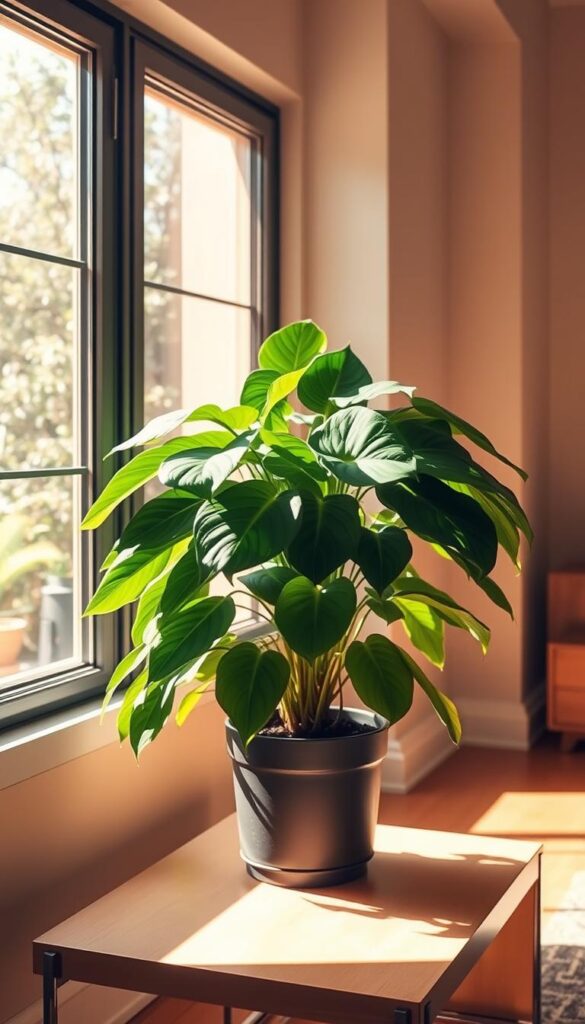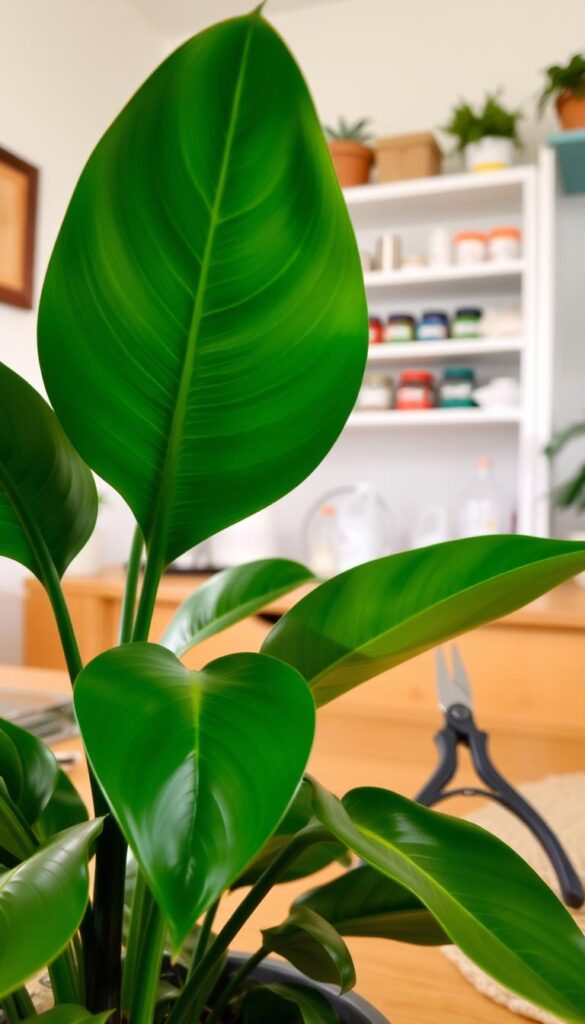Welcome to my complete guide on caring for the Philodendron Plowmanii! As a plant enthusiast, I’ve fallen in love with this stunning addition to the Philodendron family. With its unique, heart-shaped leaves, it’s no wonder why this plant has quickly become a favorite among indoor gardeners in the United States.
The Philodendron Plowmanii is a relatively new but already beloved member of the Philodendron family. Its distinctive foliage and adaptability make it a great choice for indoor spaces. However, like any plant, it has specific needs. Proper soil and watering techniques are essential—overwatering, for instance, can lead to root rot. It’s also important to note that this plant is toxic to pets and children, so safety precautions are a must.
In this guide, I’ll cover everything you need to know to keep your Philodendron Plowmanii thriving. From setting it up in your home to troubleshooting common issues, I’ve got you covered. Whether you’re a seasoned plant parent or just starting out, this guide will provide you with the confidence and knowledge to give your plant the best care possible.
Getting to Know the Philodendron Plowmanii
Uncovering the background of this fascinating plant reveals a story of discovery and uniqueness. Once mistaken for Philodendron mamei, it wasn’t until later that it earned its rightful place as a distinct species.
History and Botanical Background
The Philodendron Plowmanii was named after Dr. Timothy Plowman, a renowned botanist. Its journey from misidentification to recognition offers insights into its growth habits and characteristics.
This plant’s history shows how its unique traits were initially overlooked, leading to a deeper understanding of its needs and behaviors.
Distinctive Features and Growth Habits
One of the standout features of the Philodendron Plowmanii is its striking leaf patterns. The leaves display a mix of silver and green gradients that evolve as the plant matures, adding to its aesthetic appeal.
Compared to similar species, this plant has thicker leaves and a more compact growth habit. These differences are crucial for understanding its specific care requirements, such as pot selection and root health, which are vital for optimal growth.
Observing the small, often overlooked signs—like the way new leaves unfurl or the subtle changes in color—can reveal a lot about the plant’s health and personality. These observations have become a cherished part of my experience with this species.
Setting Up the Perfect Environment
Creating the ideal environment for your Philodendron Plowmanii is key to its health and beauty. Let’s explore how to set it up for success.
Lighting, Temperature, and Humidity Essentials
Bright, indirect light is perfect for this plant. Place it near a sunny window but avoid direct sunlight, which can scorch the leaves. A south-facing window, about 6 feet away, offers the right amount of light without overexposure.
Temperature-wise, keep it between 55°F and 85°F. Avoid placing it near drafts or extreme temperature changes. For humidity, use a humidifier, especially in dry climates. Grouping plants together can also help maintain humidity naturally.
Indoor Placement Tips for a Healthier Plant
Choose a spot with stable conditions, avoiding areas with drafts or extreme temperatures. Use a well-draining soil mix, like a soilless or aroid-specific blend, to prevent waterlogged soil.
To mimic summer conditions year-round, especially in cooler seasons, use a humidifier or group plants together. I adjust my home setup seasonally to ensure optimal light and humidity for my Philodendron Plowmanii.

Mastering the philodendron plowmanii care guide
Understanding the specific needs of your plant is the first step toward becoming a successful plant parent. The Philodendron Plowmanii thrives in environments that mimic its natural habitat, making attention to detail crucial for its health and beauty.
Watering and Soil Requirements
Watering is one of the most critical aspects of plant care. I use the soak-and-dry method to ensure the soil is moist but not waterlogged. This approach prevents root rot while keeping the plant hydrated. During spring and summer, I water more frequently, allowing the top inch of soil to dry between waterings. In winter, when the plant is dormant, I reduce watering to once every 4-6 weeks.
The soil mix plays a vital role in root health. I recommend using a well-draining mix, such as a soilless or aroid-specific blend, to prevent water from pooling at the roots. This ensures ample airflow, which is essential for healthy root development.
Fertilizer Applications for Robust Growth
Fertilizing is another key factor in promoting robust growth. During the growing season—spring and summer—I apply a balanced, diluted liquid fertilizer (20-20-20) once a month. This provides essential nutrients for leaf development and stem strength. However, I avoid fertilizing during winter when the plant is dormant, as this can cause unnecessary stress.
| Season | Watering Frequency | Fertilizer Use | Humidity Levels |
|---|---|---|---|
| Spring/Summer | Every 7-10 days | Monthly, balanced fertilizer | 50-70% |
| Winter | Every 4-6 weeks | None | 40-50% |
Watching for signs of overwatering, such as leaf spot or discoloration, is important. Healthy stem growth is a good indicator that your care routine is effective. By maintaining the right environment, including proper temperature and moisture levels, your plant will thrive year after year.
Propagation and Repotting Techniques
Propagating and repotting your houseplant can be a rewarding experience, especially when done correctly. This section will guide you through the best methods to ensure your plant thrives in its new environment.
Step-by-Step Stem Cutting Propagation
To propagate your plant, start by selecting healthy stem cuttings with at least two nodes. Remove lower leaves to expose these nodes, as they are key to successful rooting. Place the cuttings in a container of fresh water, ensuring the nodes are fully submerged. Roots should develop within a few weeks.
When and How to Repot Your Plant
Repotting is necessary when you notice signs of root binding, typically every two to three years. Choose a pot with proper drainage holes to prevent waterlogged soil, which can lead to root rot. This ensures your houseplant stays healthy and continues to grow.
Choosing the Right Soil Mix
The ideal soil mix combines indoor potting soil with perlite and orchid bark. This blend provides optimal drainage and aeration, promoting healthy root growth. Proper drainage is essential to keep your houseplant thriving.
Propagation is best done in spring or summer when the plant is actively growing. Each plant in your family may require specific care based on its growth stage, ensuring the best results for your unique houseplant.
Troubleshooting Common Issues
Even with the best care, your plant might face some challenges. Let’s explore how to identify and address these problems effectively.
Identifying Signs of Stress and Leaf Problems
Yellow leaves or brown edges often signal stress. These issues can stem from too much water, too little light, or sudden temperature changes. I check the soil moisture every week to ensure it’s not waterlogged or too dry. For instance, if the top inch of soil feels dry, it’s time to water. If it’s damp, I wait a few more days.
Moisture levels are crucial. Overwatering can lead to root rot, while underwatering might cause leaves to wilt. I also monitor the light exposure, ensuring it’s bright but indirect to prevent scorching.
Managing Pests and Preventing Diseases
Pests like mealybugs can appear, especially in warm, humid environments. I use neem oil or insecticidal soap to treat infestations, ensuring it doesn’t harm other plants. Regular inspections help catch issues early.
Diseases like root rot are often due to poor drainage. I use a soil mix with peat and perlite to improve drainage and aeration. This blend keeps the soil moist but not waterlogged, reducing the risk of disease.

By addressing problems promptly, you can keep your plant thriving. Early intervention ensures your Philodendron Plowmanii stays healthy and continues to grow beautifully.
Final Thoughts on Nurturing Your Philodendron Plowmanii
As I reflect on my journey with the Philodendron Plowmanii, I’m reminded of the joy in nurturing such a unique plant. It’s the little details—like ensuring every inch of soil drains properly or adding a sprinkle of perlite—that make all the difference. These small efforts create a thriving environment, whether you’re growing indoors or exploring its potential in warmer USDA zones.
Propagating this plant is a journey of its own. Each cutting represents a new chapter, much like watching a child grow. I’ve found that using a mix of moss and perlite in my propagation setup promotes healthy root development. It’s amazing how something so small can bring such satisfaction.
Maintaining a balanced mix of light, water, and nutrients is key. Observing your plant’s needs throughout the year and adjusting your care routine accordingly ensures it stays vibrant. Don’t hesitate to experiment—every garden, whether indoors or outdoors, is a space for learning and growth.
I encourage you to share your experiences and continue exploring new ways to nurture your Philodendron Plowmanii. Embrace the process, and enjoy the rewarding journey of helping your plant flourish.
